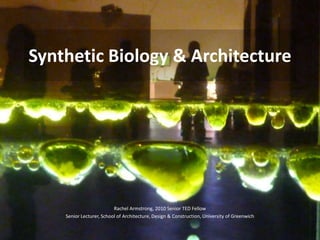
Synthetic biology and architecture
- 1. Synthetic Biology & Architecture Rachel Armstrong, 2010 Senior TED Fellow Senior Lecturer, School of Architecture, Design & Construction, University of Greenwich
- 12. Design Challenges • Equilibrium vs. non-equilibirum • Assemblages vs. machines • Infrastructure • Integration with existing architectures • Cultural considerations e.g. relationship with Nature • Ethics & safety
Notes de l'éditeur
- I work with lifelike materials that are soft and wet and the last thing that you might think of as being suitable for architecture. Conventionally buildings have provided us protection against the turbulent forces of the natural world and offers a stable environment that forms our living and social spaces. The best choices of materials for this kind of function are rigid and inert.
- When a system at equilibrium meets a vigorous one, wear and tear occurs at the interface, so need to maintain our buildings. Homebuyers will spend an annual 1% of the cost of their home every year on maintenance. As buildings get older, the amount of effort and money needed to maintain the building increases non-linearly.
- The city of Venice, which was built between the 9th and 12th centuries, is situated in a very harsh environment on the shoreline of the Po delta where it meets the Venice Lagoon before the waters flow out into the Adriatic Sea and its beautiful buildings are decaying.
- Yet if we look around the sides of the Venetian canals we can see a system that has not only been able to weather changing environmental conditions but is also able to build with them. Venice’s marine ecology use local materials and resources to create homes and niches for themselves.
- If our buildings were able to share some of the properties of living systems perhaps we may not only reduce our environmental impact for example, by ‘fixing’ carbon but also have a positive effect on our ecologies for example, increasing biodiversity or making soils. We are fortunate to live at a particular time where advances in biotechnology over the latter part of the 20th century have developed tools that enable us to design and engineer with Nature itself.
- This practice is called synthetic biology and while it is most commonly associated with DNA, the origins of the term go back to synthetic chemistry, when Stephen Leduc was comparing the forms produced by simple biological structures like fungi and self-organizing chemistries.
- Protocell ‘paints’ that ‘eat’ carbon dioxide and change colour when they are full.
- Hylozoic Ground an installation that can smell and taste its audiences and change colour to indicate this
- Future Venice, which is about growing an artificial limestone reef under the city using programmable droplets working in concert with the native marine biology
- Persephone which is about how to grow artificial soils, which are the ecosystems on which all cities are founded
- However, lifelike technologies offer a different approach that potentially may increase our portfolio of survival strategies, as we begin to negotiate the inevitable challenges that our unstable earth will present us with over the course of the 21st century.
